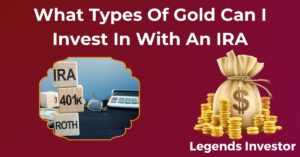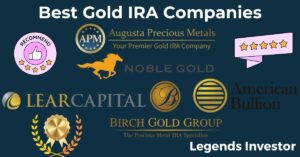Understanding Retirement Accounts and Precious Metals: An Overview
Retirement planning is a critical aspect of financial security. While traditional investments like stocks, bonds, and mutual funds dominate most Individual Retirement Accounts (IRAs), the inclusion of precious metals offers a unique avenue for diversification. This article delves into the integration of precious metals into IRAs, providing a comprehensive guide to help you make informed decisions.
Definition and Purpose of an Individual Retirement Account (IRA)
An Individual Retirement Account (IRA) is a tax-advantaged investment account designed to help individuals save for retirement. These accounts encourage long-term savings through tax benefits, allowing earnings to grow tax-deferred or even tax-free, depending on the type of IRA.
- Traditional IRAs: Contributions may be tax-deductible, and taxes are deferred until withdrawals.
- Roth IRAs: Contributions are made with after-tax dollars, but withdrawals are tax-free in retirement.
IRAs aim to provide financial security during retirement by enabling individuals to accumulate wealth over time.
Typical Investments in IRAs
Traditional IRAs often include a mix of:
- Stocks: Represent ownership in companies.
- Bonds: Fixed-income securities providing regular interest.
- Mutual Funds and ETFs: Diversified portfolios of stocks and bonds.
- Certificates of Deposit (CDs): Low-risk savings instruments with fixed returns.
In recent years, investors have explored alternatives, such as real estate, cryptocurrencies, and precious metals, to diversify their retirement portfolios.
Interest in Precious Metals as Part of Retirement Planning
Precious metals have emerged as a popular choice for retirement planning due to their potential for hedging against inflation and economic uncertainties. Gold, silver, platinum, and palladium offer a tangible asset class that retains intrinsic value over time, making them an attractive option for risk-averse investors.
Brief History of Precious Metals in IRAs
The inclusion of precious metals in IRAs became possible in 1997 with the Taxpayer Relief Act. This legislation expanded investment options for IRAs, allowing specific precious metals to be held as part of a retirement portfolio. Since then, investors have increasingly embraced precious metals for their stability and long-term growth potential.
Advantages of Diversifying Your Retirement Portfolio
Diversification is key to mitigating risks and enhancing returns. Including precious metals in your retirement portfolio offers several advantages:
- Hedge Against Inflation: Precious metals often maintain value during periods of inflation.
- Economic Stability: They provide a safeguard against market volatility.
- Portfolio Balance: Reducing reliance on traditional investments can minimize risks.
- Tangible Assets: Precious metals have intrinsic value, unlike paper-based investments.
The Legality of Including Precious Metals in Your IRA
IRS Regulations on IRAs
The Internal Revenue Service (IRS) sets specific guidelines for IRAs, including the types of investments permitted. Precious metals are allowed under strict conditions to ensure compliance.
Types of Precious Metals Allowed in an IRA
Only certain metals qualify for IRA inclusion:
- Gold
- Silver
- Platinum
- Palladium
Purity Standards for Precious Metals in IRAs
The IRS mandates minimum purity levels for precious metals:
- Gold: 99.5%
- Silver: 99.9%
- Platinum and Palladium: 99.95%
Custodian Requirements for Holding Precious Metals
Precious metals in IRAs must be held by an approved custodian or trustee to ensure compliance with IRS regulations. These custodians specialize in managing and safeguarding physical assets.
Types of Precious Metals You Can Include in Your IRA
Gold and Its Characteristics
Gold has long been a symbol of wealth and stability. Its low correlation with other assets makes it a reliable hedge against market fluctuations.
Silver and Its Market Performance
Silver is more affordable than gold and has diverse industrial applications, making it an appealing option for investors seeking growth potential.
Platinum and Its Industrial Demand
Platinum is valued for its rarity and extensive use in industries such as automotive manufacturing. Its demand often correlates with economic growth.
Palladium and Its Investment Potential
Palladium is gaining popularity due to its critical role in technology and environmental solutions, offering significant growth potential.
Choosing the Right IRA for Your Precious Metals Investment
Traditional vs. Roth IRAs
- Traditional IRAs: Tax-deferred growth, suitable for those expecting lower taxes in retirement.
- Roth IRAs: Tax-free growth, ideal for those anticipating higher taxes in retirement.
SEP and SIMPLE IRAs for Self-Employed and Small Business Owners
- SEP IRAs: Allow high contribution limits for self-employed individuals.
- SIMPLE IRAs: Designed for small businesses, offering easy setup and maintenance.
Self-Directed IRAs (SDIRAs) for Precious Metals Investing
SDIRAs provide greater flexibility, enabling investors to include alternative assets like precious metals.
Understanding the Difference Between IRA Accounts
Each IRA type offers unique benefits and tax implications. Choosing the right one depends on your financial goals and circumstances.
The Process of Including Precious Metals in Your IRA
Selecting a Custodian or Trustee
Choose a custodian specializing in precious metals IRAs. Research their reputation, fees, and customer service.
Purchasing IRS-Approved Precious Metals
Work with reputable dealers to acquire metals that meet IRS standards for purity.
The Transfer or Rollover Process from Existing Retirement Accounts
Funds can be transferred or rolled over from existing accounts into a self-directed IRA without incurring penalties.
Storage Options and Security for Physical Precious Metals
IRS regulations require physical metals to be stored in an approved depository for safekeeping and security.
Assessing the Risks and Rewards of Precious Metals in Retirement Planning
Potential for Growth in Precious Metals
Precious metals often appreciate over time, particularly during economic uncertainty.
Hedging Against Inflation and Economic Downturns
Metals retain value when paper assets decline, providing a hedge against inflation and market downturns.
Market Volatility and Liquidity Concerns
The prices of precious metals can be volatile, and their liquidity may vary depending on market conditions.
Comparing Precious Metals to Traditional Retirement Investments
While precious metals provide stability, they lack the income-generating potential of stocks and bonds. A balanced approach is crucial.
Tax Implications and Considerations for Precious Metals IRAs
Tax Treatment of Traditional and Roth IRAs
- Traditional IRAs: Contributions may be tax-deductible, but withdrawals are taxable.
- Roth IRAs: Contributions are not tax-deductible, but qualified withdrawals are tax-free.
Understanding the Potential Taxes on Gains
Gains from precious metals may be subject to taxes upon distribution, depending on the type of IRA.
Required Minimum Distributions (RMDs) and Precious Metals
Traditional IRAs require RMDs starting at age 73. Liquidating metals to meet RMDs can be complex.
Reporting Requirements for Precious Metals Transactions
Ensure compliance with IRS reporting requirements for buying, selling, and distributing precious metals.
Maintaining and Monitoring Your Precious Metals IRA
Regular Appraisals and Valuations
Periodically assess the value of your metals to understand your portfolio’s performance.
Balancing Your Investment Portfolio
Maintain a diversified portfolio to manage risks effectively.
Staying Informed About Market Trends
Monitor market developments and adjust your strategy as needed.
How to Adjust Your Strategy Based on Life Changes and Financial Goals
Review your retirement goals regularly and adapt your investments to align with life changes and economic conditions.
Expert Insights: Answers to Common Questions About Precious Metals IRAs
The Role of Financial Advisors in Setting Up a Precious Metals IRA
A financial advisor can provide valuable guidance in choosing the right IRA and investment strategy.
Can You Take Physical Possession of the Metals in Your IRA?
Direct possession is not allowed while the metals are part of the IRA. However, distributions can be taken in-kind.
Handling Inheritance and Estate Planning with Precious Metals IRAs
Precious metals IRAs can be passed on to beneficiaries. Work with an advisor to ensure smooth transitions and minimize tax implications.
Real-World Examples and Testimonials from Investors with Precious Metals IRAs
Many investors have successfully used precious metals to safeguard their retirement savings. Real-world examples highlight the benefits and challenges of this investment strategy.
Conclusion
Understanding the integration of precious metals into your IRA is essential for effective retirement planning. With careful consideration of IRS regulations, investment strategies, and market trends, precious metals can be a valuable component of a diversified retirement portfolio. Consult with financial advisors and custodians to tailor your strategy to your financial goals, ensuring long-term security and growth.



